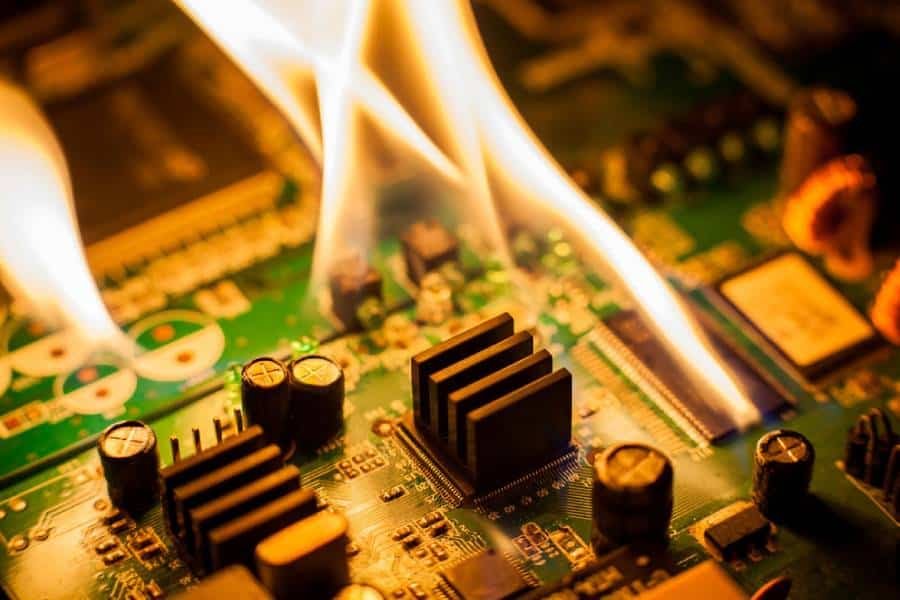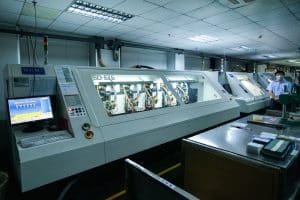In today’s fast-paced world of electronics, where devices are becoming smaller, more powerful, and increasingly complex, the demand for components that can withstand extreme conditions is on the rise. Enter heat resistant circuit boards – the unsung heroes of modern electronics that keep our devices running smoothly, even when the temperature rises.
What Are Heat Resistant Circuit Boards?
Heat resistant circuit boards, as the name suggests, are specially designed printed circuit boards that can maintain their integrity and performance in high-temperature environments. These boards are engineered to withstand heat levels that would cause standard PCBs to warp, delaminate, or fail entirely. By using advanced materials and innovative design techniques, heat resistant PCBs ensure that your electronic devices continue to function reliably in challenging thermal conditions.
Why Are They So Important?
Imagine your car’s engine control unit failing on a hot summer day, or a critical piece of industrial equipment shutting down due to overheating. These scenarios aren’t just inconvenient – they can be dangerous and costly. Heat resistant circuit boards play a crucial role in preventing such failures, making them indispensable in a wide range of applications, from automotive and aerospace to industrial machinery and power electronics.
At JHYPCB, we understand the critical nature of heat resistant PCBs in modern electronics. With years of experience in PCB manufacturing, we’ve honed our expertise in creating high-quality, heat resistant circuit boards that meet the most demanding specifications. Our commitment to innovation and quality ensures that we stay at the forefront of heat resistant PCB technology, providing our clients with cutting-edge solutions for their thermal management challenges.
As we delve deeper into the world of heat resistant circuit boards, we’ll explore the various types of materials used, key design considerations, and the industries that rely heavily on this technology. Whether you’re an engineer looking for the perfect PCB solution for your high-temperature application, or simply curious about the technology that keeps our devices running cool under pressure, this guide will provide you with valuable insights into the fascinating world of heat resistant circuit boards.
Stay tuned as we heat things up (pun intended) and explore the intricate details of these thermal warriors in the sections to come!
Understanding Heat Resistant Circuit Boards
Now that we’ve introduced the concept of heat resistant circuit boards, let’s dive deeper into what makes these PCBs special and why they’re becoming increasingly crucial in various industries.
What Makes a Circuit Board Heat Resistant?
Heat resistant circuit boards aren’t your average PCBs with a bit of extra durability. They’re engineered from the ground up to withstand high temperatures without compromising on performance. But what exactly gives these boards their heat-fighting superpowers?
- Material Selection: The foundation of any heat resistant PCB is its base material. While standard FR-4 boards might start to degrade at temperatures above 130°C, high-temperature FR-4 and more advanced materials like polyimide can withstand temperatures up to 260°C or even higher.
- Thermal Management Design: Heat resistant PCBs often incorporate specific design elements to help dissipate heat more effectively. This might include the use of thermal vias, copper coins, or strategic component placement to optimize heat flow.
- Special Laminates: Many heat resistant PCBs use laminates with high thermal conductivity, such as those found in Insulated Metal Substrate (IMS) PCBs. These help to spread heat quickly and evenly across the board.
- Robust Plating: The copper plating on heat resistant PCBs is often thicker and more durable to withstand the stress of thermal cycling.
Common Applications and Industries
Heat resistant circuit boards aren’t just for niche applications – they’re becoming increasingly common across a wide range of industries. Here are just a few areas where these thermal champions shine:
- Automotive: From engine control units to LED headlights, cars are full of electronics that need to withstand high temperatures.
- Aerospace: Aircraft engines and avionics systems operate in extreme conditions and rely heavily on heat resistant PCBs.
- Industrial Equipment: Factory automation systems, welding equipment, and other industrial machinery often operate in high-heat environments.
- Power Electronics: Devices like inverters, motor drives, and power supplies generate significant heat and require PCBs that can handle the thermal stress.
- LED Lighting: High-power LED systems can generate a lot of heat, making heat resistant PCBs crucial for longevity and performance.
Benefits of Using Heat Resistant PCBs
Investing in heat resistant circuit boards can bring numerous advantages to your electronic designs:
- Improved Reliability: By maintaining their integrity in high-temperature environments, these PCBs reduce the risk of thermal-related failures.
- Enhanced Performance: Heat resistant PCBs allow components to operate at their optimal temperature range, ensuring peak performance.
- Longer Lifespan: With better resistance to thermal stress and degradation, these PCBs can significantly extend the life of your electronic devices.
- Design Flexibility: Heat resistant PCBs allow for more compact designs and higher power densities, opening up new possibilities in product development.
- Cost-Effectiveness: While initially more expensive, heat resistant PCBs can reduce long-term costs by minimizing failures and extending product lifespans.
At JHYPCB, we’ve seen firsthand how heat resistant circuit boards can transform electronic designs. Our team of experts is always ready to help you navigate the world of high-temperature PCBs, ensuring you get the right solution for your specific needs.
In the next section, we’ll explore the various types of heat resistant circuit board materials in more detail, including the impressive capabilities of Insulated Metal Substrate PCBs and high-temperature FR4. Stay with us as we continue our journey through the hot topic of heat resistant circuit boards!
Types of Heat Resistant Circuit Board Materials
As we delve deeper into the world of heat resistant circuit boards, it’s crucial to understand the various materials that make these thermal marvels possible. Each material has its unique properties, advantages, and ideal applications. Let’s explore some of the most common and innovative materials used in heat resistant PCBs.
Insulated Metal Substrate PCB
Insulated Metal Substrate PCBs are the heavyweight champions of thermal management in the PCB world. But what exactly are they, and why are they so effective?
Definition and Structure
An IMS PCB consists of three main layers:
- A metal base layer (usually aluminum)
- A thin thermally conductive dielectric layer
- A copper foil layer for the circuit
This unique structure allows IMS PCBs to dissipate heat much more efficiently than traditional FR-4 boards.
Thermal Management Capabilities
The secret to IMS PCBs’ impressive heat dissipation lies in their metal base layer. Aluminum, with its excellent thermal conductivity, quickly spreads heat across the entire board. This prevents hot spots and allows for more even cooling.
The thin dielectric layer, while electrically insulating, is designed to be thermally conductive. This allows heat to transfer efficiently from the copper layer to the metal base.
Applications of IMS PCB
IMS PCBs shine in applications where high power density and excellent thermal management are crucial:
- High-power LED lighting
- Motor drives and controls
- Power converters
- Automotive lighting and control systems
High Temperature FR4
While standard FR4 is the workhorse of the PCB industry, high temperature FR4 takes things up a notch for more demanding applications.
Characteristics and Improvements
High temperature FR4 is engineered to maintain its electrical and mechanical properties at higher temperatures than standard FR4. Key improvements include:
- Higher glass transition temperature (Tg)
- Better resistance to delamination
- Improved dimensional stability at elevated temperatures
Temperature Range and Performance
While standard FR4 typically has a Tg around 130-140°C, high temperature FR4 can have a Tg of 170°C, 180°C, or even higher. This means it can maintain its integrity and performance at much higher operating temperatures.
Other High-Temperature PCB Materials
Polyimide
Polyimide is a high-performance polymer known for its excellent thermal stability and electrical properties. PCBs made with polyimide can withstand continuous operating temperatures up to 260°C, making them ideal for extreme environments.
Key features of polyimide PCBs:
- Excellent dimensional stability
- Low thermal expansion
- Resistance to chemicals and radiation
- Ideal for aerospace and military applications
Ceramic-Based Substrates
For the most extreme high-temperature applications, ceramic-based substrates offer unparalleled thermal performance.
Advantages of ceramic-based PCBs:
- Can withstand temperatures over 500°C
- Excellent thermal conductivity
- Low dielectric constant and loss tangent
- Ideal for high-frequency applications in extreme environments
At JHYPCB, we work with all these materials and more, helping our clients choose the perfect heat resistant PCB solution for their specific needs. Whether you’re designing a high-power LED system that needs IMS PCBs, or a satellite component that requires the extreme temperature resistance of ceramic substrates, our team has the expertise to guide you through the selection process.
Key Considerations in Designing Heat Resistant PCBs
Designing a heat resistant PCB isn’t just about choosing the right material. It’s a complex process that requires careful consideration of various factors to ensure optimal performance and longevity. Let’s explore the key aspects you need to keep in mind when designing heat resistant circuit boards.
Thermal Management Techniques
Effective thermal management is at the heart of heat resistant PCB design. Here are some techniques that can help you keep your PCB cool under pressure:
- Thermal Vias: These are plated through-holes that conduct heat from one layer of the PCB to another. Placing thermal vias under heat-generating components can significantly improve heat dissipation.
- Copper Pours: Increasing the copper area on your PCB can help spread heat more effectively. Consider using copper pours on both the top and bottom layers of your board.
- Component Placement: Strategic placement of components can make a big difference. Try to keep heat-generating components away from heat-sensitive ones, and consider the airflow around your board when deciding on component locations.
- Heat Sinks: For components that generate a lot of heat, adding a heat sink can dramatically improve thermal performance. Heat sinks increase the surface area available for heat dissipation.
- Thermal Interface Materials: Using thermal interface materials between heat-generating components and heat sinks can improve heat transfer efficiency.
Component Selection for High-Temperature Environments
Choosing the right components is crucial when designing a heat resistant PCB. Here’s what to look for:
- Temperature Ratings: Always check the maximum operating temperature of each component. Ensure it exceeds the expected temperature in your application with a safe margin.
- Thermal Resistance: Look for components with low thermal resistance (Rth) values. The lower the Rth, the more efficiently the component can dissipate heat.
- Package Types: Some package types are better at dissipating heat than others. For example, flip-chip packages often have better thermal performance than wire-bonded packages.
- Quality and Reliability: In high-temperature environments, component quality becomes even more critical. Choose components from reputable manufacturers with proven track records in high-reliability applications.
Layout Considerations for Optimal Heat Dissipation
The layout of your PCB can significantly impact its thermal performance. Here are some layout tips for heat resistant PCBs:
- Thermal Relief: Use thermal relief connections for components that need to be soldered to large copper areas. This helps with soldering while still allowing for good heat dissipation.
- Trace Width: Wider traces can carry more current and dissipate heat better. Consider using wider traces for power and ground connections.
- Layer Stack-up: In multilayer boards, consider placing high-power components on outer layers for better heat dissipation. You can also use inner layers as heat-spreading planes.
- Symmetry: Try to maintain thermal symmetry in your design to prevent board warpage due to uneven heating.
- Airflow Consideration: If your application allows for it, design your board with airflow in mind. Align components to create channels for air to flow through.
At JHYPCB, we understand that designing heat resistant PCBs can be challenging. That’s why our team of experts is always ready to assist you in every step of the design process. We can help you choose the right materials, suggest optimal thermal management techniques, and review your design for potential thermal issues.
Remember, a well-designed heat resistant PCB not only performs better but also lasts longer. By carefully considering thermal management, component selection, and layout optimization, you can create a PCB that stays cool and reliable even in the hottest situations.
JHYPCB's Heat Resistant Circuit Board Solutions
At JHYPCB, we pride ourselves on being at the forefront of heat resistant PCB technology. Our years of experience and commitment to innovation have positioned us as a leader in providing high-quality, reliable solutions for even the most challenging thermal environments. Let’s take a closer look at what sets us apart in the world of heat resistant circuit boards.
Overview of Our Heat Resistant PCB Manufacturing Capabilities
- Advanced Materials: We work with a wide range of high-temperature materials, including high-Tg FR4, polyimide, and ceramic-based substrates. Our expertise in Insulated Metal Substrate (IMS) PCBs is particularly noteworthy, allowing us to offer superior thermal management solutions.
- Precision Manufacturing: Our state-of-the-art manufacturing facilities are equipped with the latest technology to ensure precision in every aspect of PCB production. From accurate layer alignment to controlled impedance, we maintain tight tolerances crucial for high-performance heat resistant PCBs.
- Thermal Design Optimization: Our team of experienced engineers can help optimize your PCB design for thermal performance. We use advanced thermal simulation tools to identify and address potential hot spots before production.
- Customization: We understand that each application has unique requirements. That’s why we offer customized solutions, tailoring our manufacturing processes to meet your specific needs, whether it’s a special material combination or a unique board structure.
- Comprehensive Testing: Our in-house testing facilities allow us to rigorously test heat resistant PCBs under various thermal conditions, ensuring they meet or exceed the specified performance criteria.
Our Quality Control Processes for High-Temperature PCBs
Ensuring the quality and reliability of heat resistant PCBs is paramount at JHYPCB. Our comprehensive quality control process includes:
- Material Verification: We rigorously test all incoming materials to ensure they meet the specified thermal and electrical properties.
- In-Process Inspections: Throughout the manufacturing process, we conduct multiple inspections, including X-ray and thermal imaging, to detect any potential issues early.
- Thermal Stress Testing: We subject our heat resistant PCBs to thermal cycling tests, simulating the extreme conditions they might face in real-world applications.
- Electrical Testing: Every board undergoes thorough electrical testing to ensure it meets all specified parameters, even at elevated temperatures.
- Final Quality Assurance: Before shipping, each batch of PCBs undergoes a final inspection, including visual checks, dimensional verification, and performance testing.
At JHYPCB, we’re not just manufacturing heat resistant PCBs; we’re partnering with our clients to solve their most challenging thermal management problems. Our commitment to quality, innovation, and customer satisfaction drives us to continually push the boundaries of what’s possible in heat resistant PCB technology.
Whether you’re designing a new automotive system, developing high-power industrial equipment, or creating the next generation of LED lighting, JHYPCB has the expertise and capabilities to bring your heat resistant PCB designs to life. Contact us today to learn how we can help you overcome your thermal challenges and take your electronic designs to the next level!
Conclusion: Embracing the Future of Heat Resistant PCBs
As we’ve explored throughout this guide, heat resistant circuit boards play a crucial role in the ever-evolving landscape of modern electronics. Let’s recap the key points we’ve covered:
- Importance: Heat resistant PCBs are essential for maintaining performance and reliability in high-temperature environments, from automotive applications to industrial machinery and beyond.
- Materials: Advanced materials like high-Tg FR4, polyimide, and Insulated Metal Substrate (IMS) are pushing the boundaries of what’s possible in thermal management.
- Design Considerations: Effective thermal management techniques, careful component selection, and optimized layouts are crucial for creating high-performance heat resistant PCBs.
- Manufacturing Excellence: At JHYPCB, we combine cutting-edge technology with years of expertise to produce heat resistant PCBs that meet the most demanding specifications.
- Quality Assurance: Rigorous testing and quality control processes ensure the reliability and longevity of heat resistant PCBs in real-world applications.
As technology continues to advance, the demand for heat resistant circuit boards will only grow. From electric vehicles to 5G infrastructure, the need for PCBs that can withstand extreme temperatures while delivering high performance is becoming increasingly critical.
At JHYPCB, we’re committed to staying at the forefront of this exciting field. Our ongoing investment in research and development, coupled with our dedication to customer satisfaction, positions us as your ideal partner for all your heat resistant PCB needs.
Whether you’re facing a challenging thermal management problem or simply looking to optimize your current designs, JHYPCB has the expertise and capabilities to help you succeed. Don’t let heat hold back your electronic designs – contact JHYPCB today and discover how our heat resistant PCB solutions can elevate your products to new heights of performance and reliability.
Together, let’s build a future where heat is no longer a limitation, but an opportunity for innovation. Choose JHYPCB for your heat resistant circuit board needs, and experience the difference that true expertise and quality can make.
Related Reading
- A Comprehensive Comparison: Aluminum and FR4 PCBs
- Custom PCB Fabrication in China – Prototyping & Mass Production
- Aluminum PCB Prototype: The Ultimate Guide for Engineers and Designers
- Rohs Compliant PCBs: A Complete Guide to RoHS Standards for Printed Circuit Boards
- What is the Tg value of PCB substrate?












